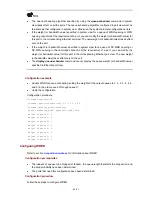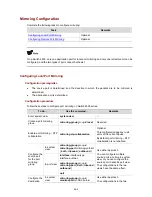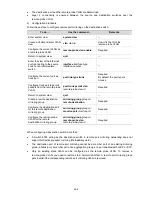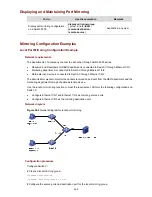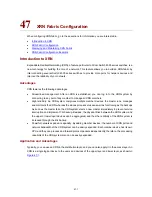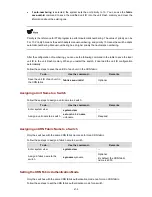
z
Do not configure a port connecting the intermediate switch or destination switch as the mirroring
source port. Otherwise, traffic disorder may occur in the network.
z
With port mirroring – STP collaboration enabled, if you configure a port in Discarding state as a
mirroring port, the port mirroring configuration does not take effect until the port transits to
Forwarding state.
z
Suppose port mirroring – STP collaboration is enabled on a device in an MSTP network. To make
the port mirroring configuration take effect on a port, make sure that the port is in Forwarding state
in all instances.
z
To enable port mirroring on an XRN fabric, you are recommended to enable port mirroring – STP
collaboration.
Configuration on a switch acting as an intermediate switch
1) Configuration
prerequisites
z
The trunk ports and the remote-probe VLAN are determined.
z
Layer 2 connectivity is ensured between the source and destination switches over the
remote-probe VLAN.
2) Configuration
procedure
Follow these steps to perform configurations on the intermediate switch:
To do…
Use the command…
Remarks
Enter system view
system-view
—
Create a VLAN and enter VLAN
view
vlan
vlan-id
v
lan-id
is the ID of the
remote-probe VLAN.
Configure the current VLAN as
the remote-probe VLAN
remote-probe vlan enable
Required
Return to system view
quit
—
Enter the view of the Ethernet
port connecting to the source
switch, destination switch or
other intermediate switch
interface interface-type
interface-number
—
Configure the current port as
trunk port
port link-type trunk
Required
By default, the port type is
Access.
Configure the trunk port to
permit packets from the
remote-probe VLAN
port trunk permit vlan
remote
-
probe
-
vlan-id
Required
Note that a Switch 4500 acting as the intermediate switch in remote port mirroring networking does not
support bidirectional packet mirroring (the
both
keyword).
Configuration on a switch acting as a destination switch
1) Configuration
prerequisites
46-7

